Are you looking for a new half dollar coin to collect? If yes, why don’t you consider the 1952 half dollar? Since this coin is old and made of silver, it could add more value to your collection.
If you wish to learn more, read about the composition, design, value, and history of the 1953 half dollar.
What Is the 1952 Franklin Half Dollar Made Of?
The 1952 Franklin half dollar is made of 90% silver and 10% copper. It has an actual silver weight of 0.36169 troy oz while its mass is 12.60 grams. Regarding size, the half dollar has a diameter of 30.61 millimeters and a thickness of 1.8 millimeters. The edge of the coin is reeded.
The 1952 half dollar was issued in 1952 and is part of the Franklin half dollar series from 1948 to 1963. The US Mint stopped producing the Franklin half dollar and replaced it with the Franklin half dollar to honor the assassinated president.

The US Mint chose John Sinnock to design the Franklin half dollar. Regretfully, he died before finishing the design. He could finish the coin’s obverse side but not the reverse. Gilroy Roberts helped in completing the design.
The obverse (head) features the image of Benjamin Franklin, one of the Founding Fathers of the United States. Inscriptions include LIBERTY, IN GOD WE TRUST, 1951.
On the reverse, you have the Liberty Bell and a small eagle on the ride side of the bell. Inscriptions include UNITED STATES OF AMERICA, HALF DOLLAR, and E PLURIBUS UNUM.
The former Mint director Nellie Tayloe Ross spearheaded the addition of Franklin to the half-dollar. She has been one of the biggest admirers of Franklin. As part of her admiration, she planned to have him on a US coin.
The Franklin half dollar met a few controversies. The initial designs of the Franklin half dollar were disliked by the Commission of Fine Arts. However, the US Mint still chose the design despite their disapproval.
Then, when the coin was released, Sinnock’s initials, JRS, were thought to refer to the Soviet dictator Joseph Stalin. Nevertheless, the design was retained, and that’s how we have the Franklin half dollar.
1952 Franklin Half Dollar Varieties
The San Francisco, Denver, and Philadelphia Mint worked together to produce more than 52 million half dollar coins. There were four regular varieties; their main difference is their mint mark and how they are struck.
Here’s a quick look at the 1952 Franklin half dollar varieties and their mintage:
| Variety | Mint Location | Mintage |
| 1952 D Franklin Half Dollar | Denver | 25,395,600 |
| 1952 S Franklin Half Dollar | San Francisco | 5,526,000 |
| 1952 P Franklin Half Dollar | Philadelphia | 21,192,093 |
| 1952 Proof Franklin Half Dollar | Philadelphia | 81,980 |
| Total | 52,195,673 |
To learn more about each of the varieties, read the following information.
1952 D Franklin Half Dollar
Year of minting: 1952
Mint Mark: D
Place of minting: Denver
Quantity produced: 25,395,600
Face Value: $0.50 (ten cents)
Price: $8.75 to $11.25 (circulated condition)
Mass: 12.5 grams
Edge: Reeded
Designer: John R. Sinnock
Composition: 90% Silver and 10% Copper
Diameter: 30.6 millimeters
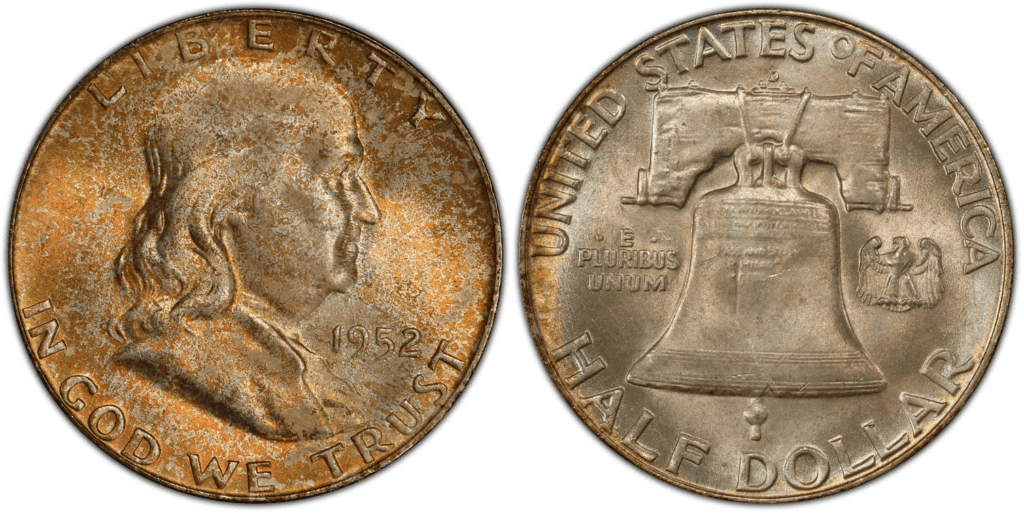
The Denver Mint produced more than 25 million half dollars in 1957, the most of the 1952 50-cent variety for that year. This was a new record for the Denver Mint’s production of half dollars. However, the record would eventually be broken just two years later.
1952 S Franklin Half Dollar
Year of minting: 1952
Mint Mark: S
Place of minting: San Francisco
Quantity produced: 5,526,000
Face Value: $0.50 (ten cents)
Price: $8.75 to $11.25 (circulated condition)
Mass: 12.5 grams
Edge: Reeded
Designer: John R. Sinnock
Composition: 90% Silver and 10% Copper
Diameter: 30.6 millimeters
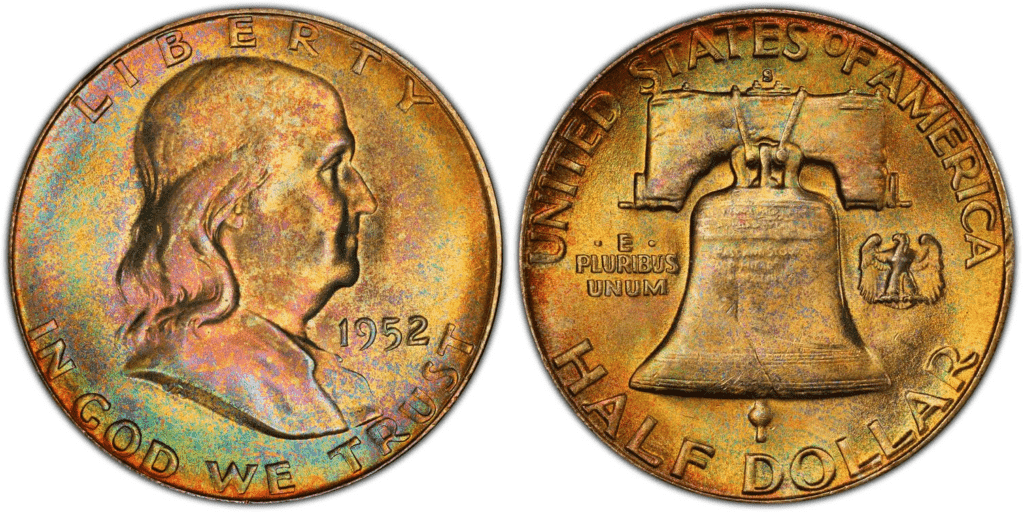
The San Francisco Mint produced more than 5 million half dollars. This is certainly lower than what the other mints have produced. According to some historians, the low mintage was a cutback since in 1951, the San Francisco Mint issued a lot of half dollars. So, by 1952, there were enough half dollars, and the production slowed down.
1952 P Franklin Half Dollar
Year of minting: 1952
Mint Mark: none
Place of minting: Philadelphia
Quantity produced: 21,192,093
Face Value: $0.50 (ten cents)
Price: $8.75 to $11.25 (circulated condition)
Mass: 12.5 grams
Edge: Reeded
Designer: John R. Sinnock
Composition: 90% Silver and 10% Copper
Diameter: 30.6 millimeters
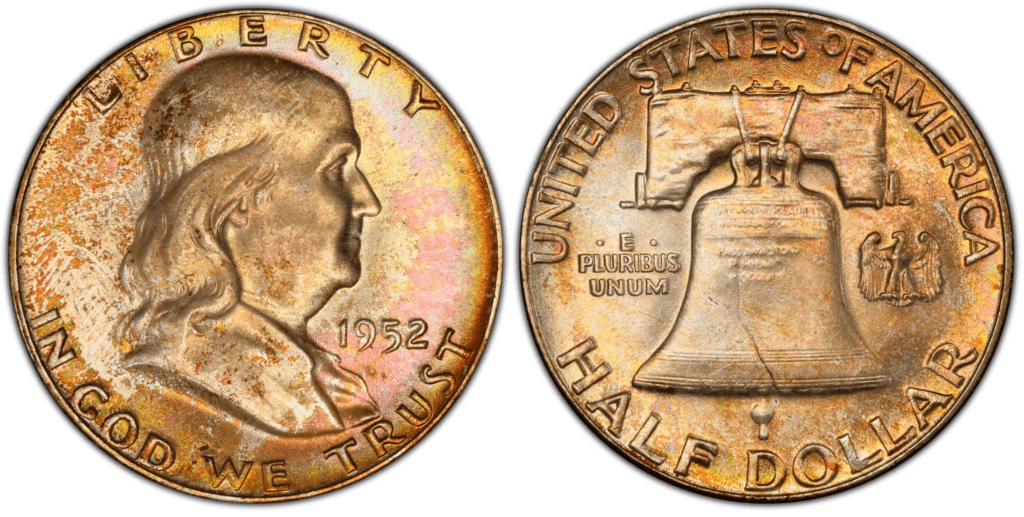
The Philadelphia Mint produced more than 21 million half dollars in 1952. At that time, this was already considered a high mintage. Normally, with high mintage comes poorly struck coins. However, this wasn’t the case in 1952. There were many nicely struck half dollars coming from the Philadelphia Mint at that time.
1952 Proof Franklin Half Dollar
Year of minting: 1952
Mint Mark: none
Place of minting: Philadelphia
Quantity produced: 81,980
Face Value: $0.50 (ten cents)
Price: $59 or more (uncirculated condition)
Mass: 12.5 grams
Edge: Reeded
Designer: John R. Sinnock
Composition: 90% Silver and 10% Copper
Diameter: 30.6 millimeters
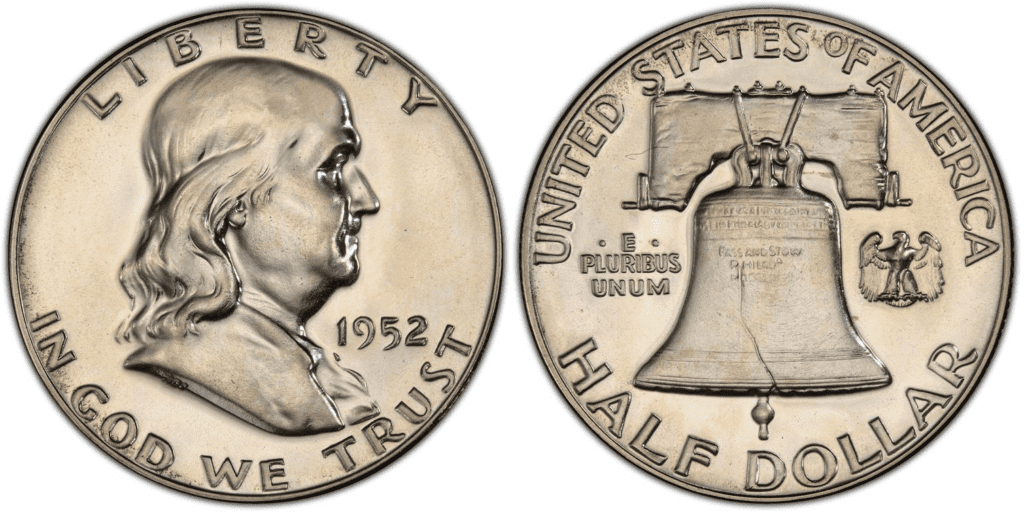
The Philadelphia Mint produced almost 82 thousand proof coins in 1952. This is considered the lowest mintage for the Franklin proof half dollar series. You should easily find 1952 S proof 50 cents up to PR65. However, it can easily get scarce from grades PR 66 and above. Aside from that, 1952 proof half dollars with cameo surface can be very difficult to find.
List Of 1952 Franklin Half Dollar Errors
Error coins happen due to mechanical errors. Sometimes, it could also be because of human errors. Nevertheless, every coin series has its fair share of error coins, and the 1952 Franklin half dollar series is no exception.
Here are some of the most common errors found in 1952 Franklin half dollars:
Strike-through error
The strike-through error happens when something gets stuck on the planchet or die during the strike. During minting, dust, grease, metal clippings, and dirt can go between the die and planchet. So, the die strikes through the foreign material at the moment of the strike and leaves an unnecessary mark on the coin.
Here’s an example of a strike-through error on a 1952 half-dollar coin:
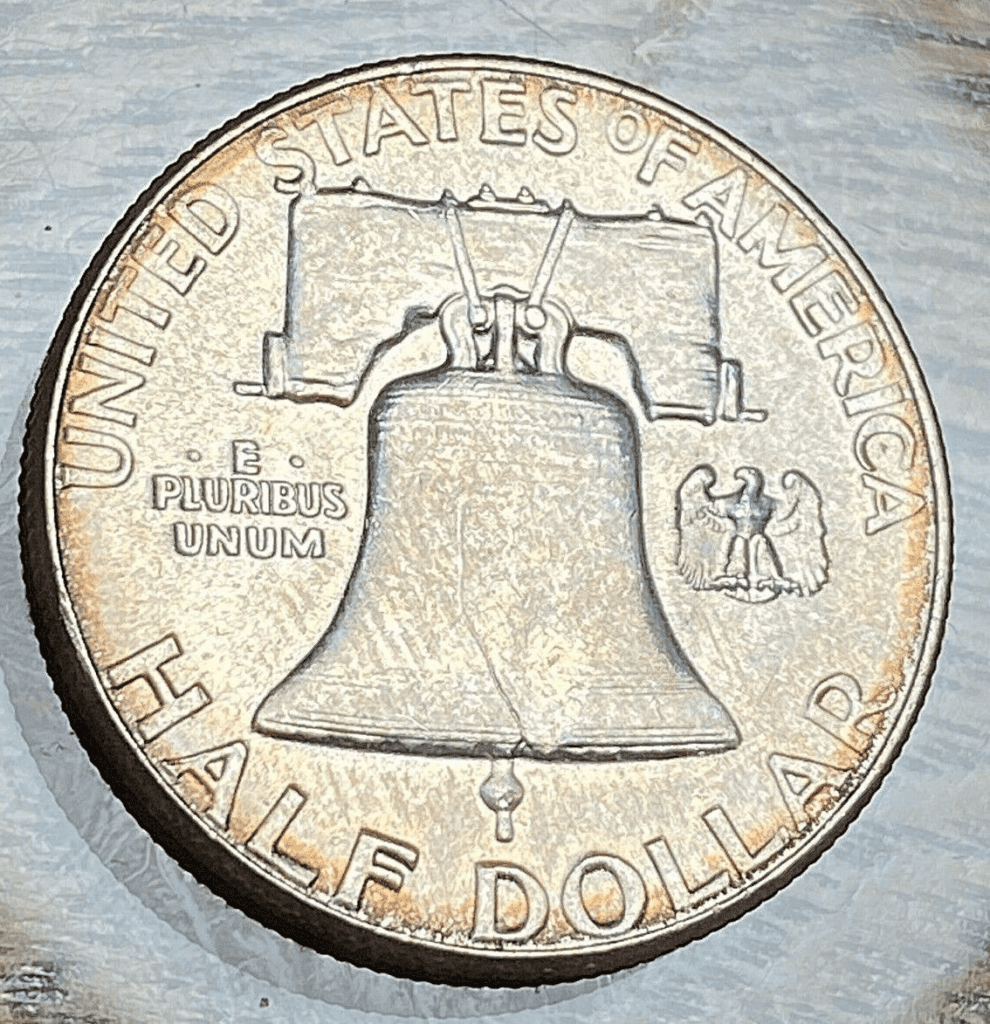
The strikethrough marking is found on the clapper of the bell.
Die clash Bugs Bunny error
Die clash happens when the obverse and reverse die hit each other. This happens when the dies try to strike the planchet, but the planchet isn’t there. As a result, the two dies hit each other.
Because of the tremendous force of the impact, the dies can damage each other. In this case, the damage caused Franklin’s lips to get distorted, and most folks call it the “Bugs Bunny” Franklin coin.
Here’s how it looks on a 1952 half dollar:
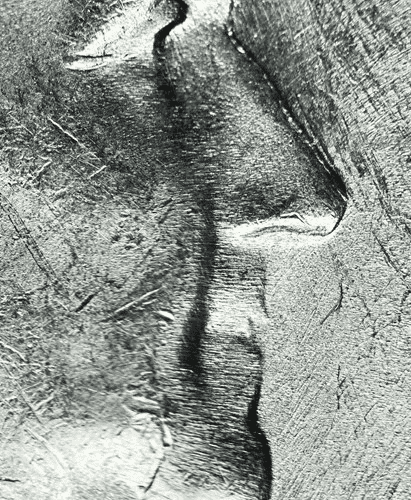
Repunched mint mark
The repunched mint mark (RPM) is an error when the mint mark is punched twice on the planchet. Sometimes, the second strike hits the planchet from a different angle. As a result, there’s a visible doubling of the mint mark.
Here’s an example of a double S over S RPM error on a 1952 half dollar coin:
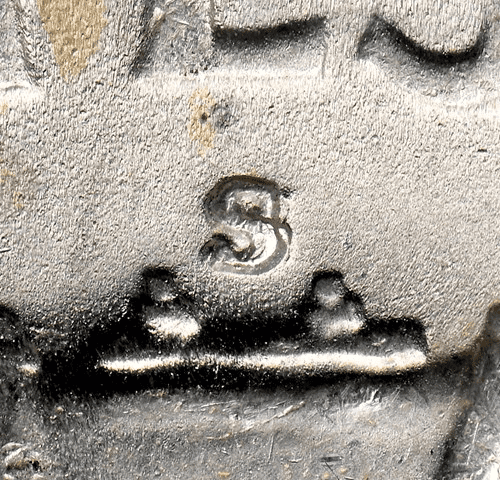
How Much Is 1952 Franklin Half Dollar Worth Today?
The 1952 Franklin half dollar has a face value of 50 cents. Its melt value is $7.9139. The melt value is higher since it’s made of silver. According to NGC, the usual price of a circulated 1952 half dollar coin is between $8.75 to $11.25.
While these numbers may already be high, you would be surprised that there are 1952 50-cent coins that are more valuable than their face value of melt value.
Here’s a table that shows you the auction records for each of the 1952 Franklin half dollar coins:
| Coin | Condition | Grade | Sold date | Sold by | Value |
| 1952 P Franklin Half Dollar | Superb Gem Uncirculated | MS 67+ (Full Bell Lines) | January 27, 2019 | Legend Rare Coin Auctions | $42,300 |
| 1952 S Franklin Half Dollar | Superb Gem Uncirculated | MS 67 (Full Bell Lines) | November 6, 2014 | Heritage Auctions | $25,850 |
| 1952 D Franklin Half Dollar | Superb Gem Uncirculated | MS 67 (Full Bell Lines | November 16, 2012 | Stack’s Bowers | $18,800 |
| 1952 Proof Franklin Half Dollar | Superb Gem Uncirculated | PR 67 (Deep Cameo) | January 9, 2013 | Heritage Auctions | $18,800 |
How Does The Grading System Work?
Professional numismatists joined in the 1970s and established CoinGrading standards, known as the Sheldon Scale. These numismatists now assign grades at key places on the seventy-point scale, using the most regularly utilized numeric points in conjunction with the original adjective grade. The following are the most common coin grades:
- (P-1) Poor – Indistinguishable and probably damaged; if used, must have a date and mintmark; otherwise, rather battered.
- (FR-2) Fair – Nearly smooth, but without the damage that a coin graded Poor often possesses. The coin must have enough detail to be identified.
- (G-4) Fair – Inscriptions have merged into the rims in some areas, and important elements have been mostly erased.
- (VG-8) Very Good- A little weathered, but all primary design elements are visible, albeit faintly. There is little, if any, central detail left.
- (F-12) Good – The item is very worn, yet the wear is even, and the overall design details stand out clearly. Rims are almost completely isolated from the field.
- (VF-20) Very Fine – Moderately weathered, with some finer features still visible. The motto or all letters of LIBERTY are readable. Both sides of the coin have entire rims separated from the field.
- (EF-40) Extremely Fine – Gently used; all gadgets are visible, and the most important ones are bold. The finer details are bold and clear; however, light wear may be seen.
- (AU-50) Uncirculated – Slight evidence of wear on the coin’s design’s high points; it may have contact marks; eye appeal should be adequate.
- (AU-58) Uncirculated Choice – Slight traces of wear, no severe contact marks, almost full mint shine, and great eye appeal.
- (MS-60) Mint State Basal – Strictly uncirculated; no indication of wear on the coin’s highest points, but an unsightly coin with reduced luster, visible contact marks, hairlines, and other flaws.
- (MS-63) Mint State Acceptable – Uncirculated, but with contact scratches and nicks, little reduced shine, but otherwise appealing appearance. The strike is weak to average.
- (MS-65) Mint State Choice – Uncirculated with great mint shine, little contact blemishes, and exceptional eye appeal. The strike is unusually severe.
- (MS-68) Mint State Premium Quality – Uncirculated with superb luster, no obvious contact marks to the naked eye, and exceptional eye appeal. The strike is quick and appealing.
- (MS-69) Almost Perfect Mint State – Uncirculated with perfect brilliance, a sharp and appealing strike, and extremely good eye appeal. A near-perfect coin with minor imperfections in the planchet, strike, and contact markings (seen only under 8x magnification).
- (MS-70) Mint State Perfect – Under 8x magnification, no tiny imperfections are discernible; the strike is crisp, and the coin is perfectly centered on a beautiful planchet. Rarely seen on a coin, this coin is bright and whole, with original luster and exceptional eye appeal.
For half dollar coins such as those that came out in 1952, there’s a specific designation given to them, known as the Full Bell Lines (FBL). It’s an indication of whether a coin is fully struck or not.
Where To Buy Or Sell 1952 Franklin Half Dollar?
You can buy or sell 1952 Franklin half dollars online and offline. If you opt for online, you can try Amazon, eBay, Etsy, Coin Appraiser, USA Coin Book, and Grey Sheet.
You can also visit coin shops, antique stores, pawnshops, and auction houses for more options in buying and selling 1952 Franklin half dollars.
FAQs
Where is the mint mark on a 1952 half dollar?
The mint mark on a 1952 half dollar is found above the beam of the Liberty Bell.
How much does a 1952 silver half dollar weigh?
The 1952 silver half dollar weighs 12.50 grams.
Is a 1952 half dollar silver?
Yes, the 1952 half dollar is made of 90% silver and 10% copper.
